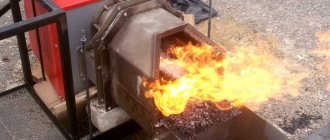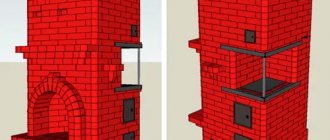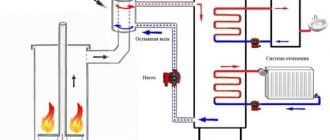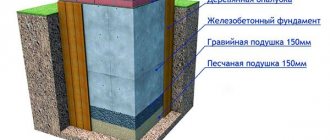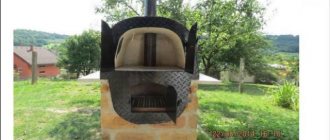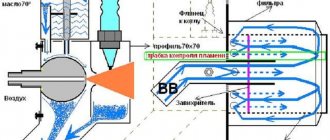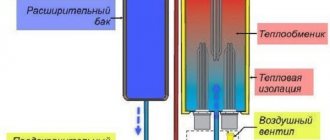- Furnace in production: options for making the device yourself
- Advantages and disadvantages of a waste oil stove
- Operating principle of a waste oil furnace
- Waste oil furnace : types of designs
- Requirements for installation and operation of an oil furnace
- DIY options for increasing the efficiency of a mini-oven
- Popular options for pre-fabricated furnaces, their characteristics
- Do-it-yourself stove made of sheet metal and pipes
- Step-by-step instructions for making a waste oil stove with your own hands from a cylinder
- Making a tray for working off and installing a chimney for an oil stove with your own hands
- Video: a new furnace using a gas cylinder.
- How to make a pyrolysis type stove
- Video: drawings and assembly of a waste oil furnace
Furnace in production: options for making the device yourself
With the approach of cold weather, many craftsmen are coming up with various designs for heating the room and heating water. First of all, the question is about the type of fuel. In search of the most rational and cheapest option, many choose to work off, the average consumption of which is about 2 liters per hour. A waste oil furnace has a number of advantages. Knowing all the intricacies of its manufacture, you can create a budget-friendly and efficient source of heat in the house.
Garage stove: photo examples, varieties, how to make it yourself (read more)
Creating a homemade stove for mining is not a labor-intensive process.
Valuable recommendations
A furnace undergoing testing does not require professional knowledge or any unique maintenance. But the main thing is to take advice from knowledgeable people. Especially when it is installed with your own hands. A heat generator installed to heat a garage still requires simple maintenance. The built furnace is in operation by the creator, in other words, the person who owns the “motorhome”. He is obliged:
- Adjust the use of waste oils.
- Correct heating strength.
- Use waste petroleum oils for heating.
- Be able to select only used oils for heating that can be regenerated.
- Use industrial, motor, and transmission oils that have been used for heating.
A stove in a car garage with your own hands during testing is also used to heat other objects. It’s easy to make a drawing of a furnace for testing yourself. The multi-purpose exhaust furnace is the most popular among car enthusiasts.
Advantages and disadvantages of a waste oil stove
A factory or homemade waste oil furnace is characterized by a number of advantages:
- ensuring fast and efficient heating of enclosed spaces in the form of greenhouses, domestic buildings, warehouses and technical rooms;
- independence of the device from electricity and gas;
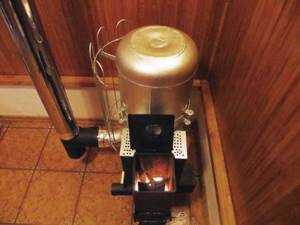
When ensuring normal operation, the stove does not create a lot of soot and burning.
- unique design features of the device that allow you to carry out the cooking process;
- ease of operation;
- no open flame;
- reliability of the structure, which is made of metal products connected by welding;
- when ensuring normal operation, the stove does not create a lot of soot and burning;
- due to its light weight and dimensions, the device can be transported;
- the stove can be made from scrap metal;
- during operation of the device, combustion of oil and its vapor is ensured;
- The stove can be combined with a water heating system by installing a tank on top.
A closed type furnace is not without its drawbacks, among which are the following:
- the possibility of clogging the supply tube with waste oil;
- the need to install a chimney with a length of at least 4 m;
- presence of hot open surfaces;
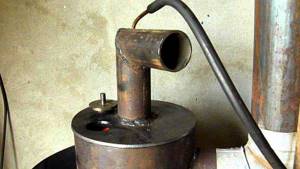
The exhaust furnace provides fast and efficient heating of various types of enclosed spaces.
- weekly cleaning of the chimney and oil container from accumulated waste;
- high probability of contamination of clothing and premises during contact with fuel;
- the container with fuel should be located in a warm room;
- unpleasant smell of used oil;
- the flame in the apparatus can be extinguished only after the fuel has completely burned out;
- if used incorrectly, the fire hazard increases;
- characteristic humming noise during operation of the furnace;
- The fuel ignites only when it is heated to its flash point.
Note! Before pouring oil into the system, it should be filtered.
Rules of operation and safety
No matter how much they talk about the safety of homemade stoves, they remain devices, improper handling of which can lead to burns or fire of surrounding objects. As a result, there are a number of prohibitions.
The following actions cannot be performed:
- use other types of fuel instead of used oil;
- use faulty equipment;
- install a heating device in a room without well-established ventilation;
- light a fire if the stove is not equipped with a smoke exhaust duct;
- block the hole in the burner;
- leave the room with the stove running for a long time;
- place flammable liquids or objects near the heated body;
- Spray oil or water onto the hot surface.
Only adults have the right to use the stove; children or animals are not allowed near it while the unit is operating.
Operating principle of a waste oil furnace
The prototype for oil furnaces operating on waste oil is kerogas, which was previously used in villages and dachas. It used kerosene as fuel, the vapors of which were burned in a separate chamber. To save on fuel, a waste oil burning option was developed. It can be purchased for free or at a reasonable cost at any service station.

Components of a waste oil stove.
Creating a homemade stove during mining is not a difficult process. The main task is to properly organize the system for a productive oil combustion process. To ensure complete combustion of vapors, heavy components must first be split into light ones, which is carried out as a result of pyrolysis. The oil must be properly heated for efficient evaporation.
The operating principle of an oil furnace during mining is as follows. First of all, the mining is ignited in the lower chamber of the apparatus. The combustion intensity is regulated using a throttle valve in the device body, through which air enters the chamber. Oil vapor mixed with oxygen rises upward through a vertical pipe. The pipe is connected to the upper tank, which is the afterburner chamber.
The mixture is mixed under the influence of the Coriolis force (force of inertia). The intensity of the process is achieved by choosing the correct diameter and length of the combustion chamber. To ensure complete combustion, air must flow through the damper in sufficient quantity. To do this, it is additionally sucked through holes made in a vertical perforated pipe connecting the tanks.

The combustion intensity is regulated using a throttle valve in the device body.
The gas flow is directed to the final combustion chamber, in which the upper part is expanded. During its manufacture, a horizontal separation is made between the chimney inlet and the combustion chamber outlet, which is necessary to ensure a temperature jump between the nitrogen oxide and oxygen afterburning zones. At temperatures below 600 °C, nitrogen oxides are more active than oxygen. As they decompose, they oxidize fuel particles. With increasing temperature, oxygen acts as the main oxidizing agent. Harmful substances are released into the atmosphere through the chimney.
Note! To ensure efficient oil combustion in the upper tank, the temperature must be low.
Advantages and disadvantages of a homemade stove
The first and most important advantage of a stove used in a garage is the low cost of fuel and the almost free manufacturing cost. Such stoves can be purchased from craftsmen who make money during the season by making them, or they can be easily and quickly made with your own hands.
As for fuel, there will be no problems with this at all. Even if you don’t have a supply of used oil drained from your car, most car repair shops will be happy to give away their supplies for free for pickup. Fuel consumption in such a stove is approximately 500 - 800 ml per hour, which means that no more than five liters of oil will be needed for a full working day. This is where the oil stove for the garage compares favorably with its old predecessor - an ordinary potbelly stove, in which the consumption of solid fuel is simply enormous. And at current prices for firewood, it will significantly hit your pocket, especially if you have to heat the room every day. You can store used oil in five-liter plastic cans, since it is quite difficult to ignite and does not pose any danger during storage.
A stove designed for a garage with your own hands heats up very quickly and during operation practically does not produce smoke or smell, which is its undoubted advantage.
Disadvantages include the fact that no fuel other than oil can be used in the furnace during mining. It is very important that the oil is cleared of water, since during the combustion process the water in the tank should not boil under any circumstances; this can lead to strong splashing of boiling oil, comparable in strength to an explosion. This is the main safety precaution when operating the stove during testing.
Another important nuance when using the stove during testing is the end of its operation. Even if all the holes in the combustion chamber are closed, the temperature will be maintained sufficient for the oil to burn. If you block the chimney, suffocating, greasy smoke from combustion products will flow from the oil stove chamber into the room. Therefore, it is very important to pour fuel in such a way that it is completely burned out by the end of the working day or the time when you need to leave the premises.
Important! During operation of the stove, waste from burning oil is generated in the internal tank, which will have to be cleaned out. To prevent this from becoming a problem, the design of the oil tank must be collapsible.
Waste oil furnace: types of designs
There are several types of oil furnaces that operate on waste oil. The classic model is the pyrolysis apparatus. It is made from ready-made containers in the form of barrels, pipes, cylinders or from alloy sheets. Oil is poured into the lower vessel, which splits when there is insufficient air. In the upper tank, intensive combustion of its vapor occurs, due to which a lot of heat is released.
Temperature regulation is carried out by air supply. Such a furnace requires constant cleaning of the chambers from accumulated fractions. It does not have mechanical temperature control.

Oil is poured into the lower vessel of the stove, which breaks down when there is insufficient air.
At the oil recovery stove, a guaranteed air supply to the second chamber is realized with the help of a fan. The combustion process is more efficient, so warm air evenly enters the room.
The operating principle of a stove with a drip supply of fuel is similar to the operating mechanism of diesel engines. It is economical. However, the independent process of manufacturing the device is very labor-intensive, so it is better to purchase a factory device of this type. In addition, it should be taken into account that homemade drip stoves are picky about the quality of the oil, which must be preheated before feeding into the stove.
The most efficient model is a supercharged waste oil furnace. It, in comparison with a potbelly stove, has a higher cost. Additional heat comes from blowing fans. Supercharging can be done using a car cooler motor, and the heater is blown by a 220 V home propeller.
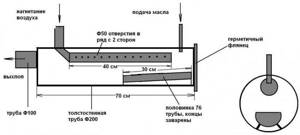
Standard layout of a waste oil furnace.
telepnev › Blog › Heat in the garage. The furnace is being worked out.
And so, the devil of the machine and the first launch arose.
I installed it as planned in the basement. A friend helped with the installation. More precisely, he didn’t help, but I helped him, he did everything. He cut a hole in my roof, which I took so long and diligently to make. I cut a hole in the floor that I had been making for so long and diligently. Welded a pipe. It turned out to be a bit short, so we went to buy another meter.
In general, they installed it, assembled everything, screwed it on, poured oil and began to try to start it.
You don't need to look at what's going on with the floor. This is the basement, I cleaned it up a bit more. I took out 12 bags of rotten pieces of wood and all sorts of garbage. Now the floor in the basement is a mixture of clay and sand. I'll get everything in order next summer.
Let's return to the stove. It took some effort to get it running. Really long. However, this is the first launch of this kind, then it got stuck. They got a little work off. Maybe there’s more work like this, thickening it’s a mess. They set it on fire with a sponge soaked in solvent. I think we need to stir up some diesel fuel for ignition. It flared up and, as a rule, began to burn beautifully. The walls began to float). It was not possible to warm up the room, firstly there was not enough oil, secondly, the holes in the roof had not yet been repaired. I worked for about 2 hours until the oil ran out. I ate less than 1.5 liters. The stove itself is warm, the chimney is also warm, but the room is not warm enough to warm up. But again, holes in the ceiling. There was a real draw to them.
The next day, it was planned to install homemade sandwiches in the places where the pipe passes through the floor and roof. Plus fix the gate. In general, I arrived early and started making transition boxes. Then my friend pulled himself up. The matter went wrong. I sawed down a box in the roof, filled it with cotton wool, and when I started making the bottom cover it dawned on me. I didn’t take into account the thickness of the log, but I still have a ceiling. Jamb. But don’t be afraid, if necessary, the box can be expanded. And that’s not necessary at all. The box does not heat up, I will also stuff this part of the ceiling around the pipe with cotton wool and cover it with a sheet of galvanized steel.
I didn’t show off too much on the floor either. I simply made a screen out of sheet metal along the edges of the opening, wrapped cotton wool around the pipe, secured it with wire and covered it with a simple lid. Just so that I don’t have to grab onto the whole thing and it looks more decent. All.
Requirements for installation and operation of an oil furnace
It is required that the stove be located in an empty room, near which there should be no flammable surfaces. Particular attention is paid to self-made devices. They should not be placed on a shelf or other support that could catch fire.
A homemade furnace for mining should be located on a flat base, which can be concrete or brick. It is necessary that the distance between the apparatus and the wall be at least 1 m. To create good draft, the chimney must have a length of more than 4 m. Insulation should be provided on its external side to prevent the formation of acid condensation.
The used oil should not contain any solvent or other flammable element, so such components should be kept away from the furnace. It is also unacceptable for moisture to get into the container with oil. This will cause a fire in the oven. In the event of an emergency, a fire extinguisher should be used to extinguish the fire.
Note! In the room where the stove is located, there must be a good system of natural supply and exhaust ventilation.

The operating principle of a stove with a drip supply of fuel is similar to the operating mechanism of diesel engines.
Before starting work, oil is poured into a container in an amount equal to half the volume of the tank, which will provide the necessary space for the formation of vapor. For the vapors to become enriched with oxygen, you need to wait some time. Then the fuel is ignited using long matches. As soon as the process of ignition of vapors begins, the damper is closed halfway.
To increase the performance of the mini-furnace during mining, you can install a sealed tank with liquid above its upper chamber. To supply and drain water, fittings are attached to it, which are located at different levels. Another option for increasing productivity is the necessary air convection, which is carried out using a fan located near the upper chamber. By taking warm air from the stove, it helps to cool it, which has a positive effect on the life of the device.
Design features of the furnace, dimensions and drawings of existing units
As noted above, a two-volume potbelly stove consists of several main elements:
- lower container with air damper;
- upper heat exchanger with baffle and outlet pipe;
- vertical diffuser with perforation;
- supporting elements of the structure.
The lower and upper modules are cylindrical containers with a diameter of 35–45 cm, which are connected by a thick steel pipe with a diameter of at least 100 mm. Its length must be at least 40 cm, otherwise the unit will not provide conditions for saturating oil vapors with oxygen. For the same purpose, drillings with a diameter of at least 9–10 mm were made across the entire surface of the vertical chamber, which were placed in a checkerboard pattern.
The lower tank rests on four legs 10–15 cm long, made of a profile pipe measuring at least 30x30 mm. On its upper surface there is a hole with a diameter of 50–70 mm, which is closed with a rotary valve.
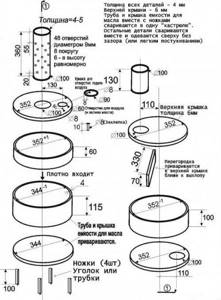
Drawing of an easy-to-make two-chamber potbelly stove
Inside the upper module, closer to the outlet pipe, a metal strip is installed, which is necessary to reduce the gas flow rate. Since the heated gas rushes upward, the partition is mounted on the top cover. There should be a gap of at least 25–30 mm at the bottom of the tank, which will be enough for a complete gas outlet.
The stove pipe is connected to the unit through a pipe cut into the side wall of the upper module. A detachable connection is necessary in order to periodically clean the smoke channel from soot and carbon deposits. By the way, the height of the chimney must be at least 4 m, otherwise the draft will not be enough for intense combustion. In order to increase heat transfer, part of the chimney pipe is laid horizontally. In this case, even a segment of 0.5–0.8 m will be enough to enhance convection heat transfer. As for the material of manufacture, at a distance of at least 1 m from the outlet pipe of the stove, the chimney must be made of thick steel pipe. Next, the channel can be expanded with any available materials - galvanization, tin, ceramics, etc.
All parts of the potbelly stove are made of steel with a thickness of at least 4 mm. The upper module and vertical chamber are welded together with the casing of the lower tank. These elements must be fitted to the fuel module body as closely as possible. Of course, it would be possible to make the potbelly stove non-separable, but subsequently simplifying the design will result in difficulties when cleaning the unit from carbon deposits.
Photo gallery: drawings of two-volume potbelly stoves

Drawing of a two-volume heating device under development

Drawing of a potbelly stove with forced air supply

Drawing of a unit for working on engine oil
The diagrams and drawings that are presented to your attention allow you to determine the amount of material required and understand the design features. If for some reason the dimensions of the potbelly stove do not suit you, then they can be changed in any direction, observing the basic ratios. By the way, it is not necessary to make a device with cylindrical tanks. If you make the containers rectangular, then you can save time and effort when cutting out the parts of the stove with a grinder. Nevertheless, let us warn those who immediately jumped at this idea. The fact is that corners are places where combustion products accumulate, so cleaning such a stove will be much more difficult.
DIY options for increasing the efficiency of a mini-oven
Waste oil furnaces are often used to heat a garage or small workshop. It is not recommended to use such a device in a building where people are constantly present. This is due to the fact that the stove absorbs oxygen, which has a negative effect on the human respiratory organs. If the device is intended to heat a living space, it should be located in a separate room.

It is not recommended to use such a stove in a room where people are constantly present.
To improve the efficiency of the device, additional devices can be used. A waste oil furnace with a water circuit is organized by tying the coil body or installing a water jacket on the chimney. In the first case, the coil is made of copper pipe. It is built into the heating system of the house.
The water jacket is made of sheet metal in the form of a container, which is located in the upper part of the housing. It circulates a liquid coolant. For the stove to operate efficiently, the tank must contain up to 30 liters of water. Such a device will allow you to heat a large area.
An exhaust furnace with a water circuit must be equipped with an expansion tank with an emergency drain, necessary in case of boiling of the liquid. It is not recommended to install a membrane container here.
Another option for increasing the efficient operation of the furnace is to use an air heat exchanger, which is represented by a fan. No design changes are made to the device, and the heating of the room is improved. The fan is located near the upper chamber. When it cools, the heated air spreads across the area of the room. You can also pass air through a box located on top of the stove, or through a pipe that is installed in the afterburner chamber.
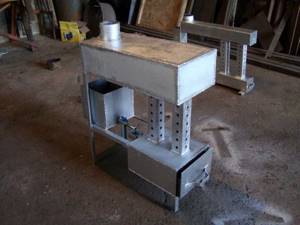
An exhaust furnace with a water circuit must be equipped with an expansion tank with an emergency drain.
Model of a wood-burning stove made from a receiver tank
A receiver tank would also be a good option for installing a furnace. It is already equipped with a hatch cover, which will serve as an alternative to the combustion door. For the convenience of loading firewood, you only need to equip it with a handle. A hole must be cut at the bottom of the tank to remove any remaining flammable materials. You can study the diagram of a wood-burning stove in more detail, as well as find comprehensive answers to many questions on our website.

[Photo 6 The design for the receiver tank is designed to accept both liquid and gaseous media.]
This model of heating system does not have any difficulties in manufacturing, but you will need to take precautions during operation. The downside of this option is the inconvenience of cleaning the ash pan.

[Photo 7 A grate is installed in the tank, which serves as a distributor of furnace sections.]
Another good option is a mini-stove, made independently from alloy steel. In the image you can see a drawing diagram of the simplest model of a furnace device, which can be made from sheet metal, with the necessary dimensional grid of all elements. By equipping it with two partitions that create a labyrinth in the chamber, which allows for slow burning of wood, the stove extracts maximum efficiency from fuel materials.
In addition to this article, we recommend that you familiarize yourself with the drawings of the smokehouse brick structure on our website.

[Photo 8 Sheet metal lends itself well to bending, so when used, the stove can acquire a variety of modifications.]
Popular options for pre-fabricated furnaces, their characteristics
The Teplamos NT-612 stove is often chosen as a device used for heating a garage. The power of such a drip fanless heater can vary between 5-15 kW. Fuel consumption is 0.5-1.5 l/hour.
This furnace for use in a garage is a closed type device. It is equipped with a chimney, an air supply pipe and a built-in tank designed for 8 liters of fuel. Fuel combustion occurs in the inner chamber. The operation of the device begins with electrical heating of the plasma bowl. When the required temperature is reached, fuel is supplied and air is forced into the combustion chamber. The average cost of the device is 30 thousand rubles.
Note! For normal operation of the stove, it must be preheated with a small amount of diesel fuel, which is poured into a special bowl.
Another popular model is the Zhar-25 (MS-25) stove. This device can operate not only on waste oil, but also on diesel fuel. The device operates from the electrical network, which powers the internal fan. The thermal power of the furnace varies from 25 to 50 kW. It is designed to heat a room up to 500 square meters. m. Maximum fuel consumption is 4.5 l/hour. The device has large dimensions. Its weight reaches 130 kg. This stove needs to be equipped with a good chimney. You can buy it for 45 thousand rubles.
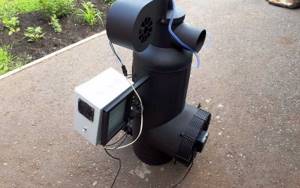
The exhaust furnace is equipped with a chimney, an air supply pipe and a built-in tank.
Assembly work
- The installation process with your own hands must begin with installing the case. Legs are attached to it using portable welding, on which the heat apparatus will stand. Strong metal is used. The height of the legs should not be less than 30 cm.
- Monitor the quality of the seam during installation. It should be completely impenetrable. During welding work, there should be no flammable materials inside the garage.
- After completing this work, it is necessary to work on the chimney. Here you can hardly do without an angle grinder. With its help, holes are cut that start from the body somewhere at a distance of 10 cm and end half a meter from the floor.
- Next comes the installation of the heating device. It should be installed closer to the garage doors. Another hole is drilled for fastening. When this work is successfully completed, welding is again used to firmly and tightly connect the parts of the pipe and the heat generator.
- All welding work must be performed efficiently. When the heating device is placed in a horizontal position of the floor, another hole with a diameter of 5 cm is cut on top of the chimney. It is needed for real purging of the stove.
Fire up the furnace for mining with a hydraulic circuit as follows:
- Take a certain amount of oil and pour stove fuel (100mm) onto it;
- Then a rag soaked in heating oil is used and it is ignited.
- Used oil is topped up in portions so that the functionality of the heat generator is not interrupted.
Do-it-yourself stove made of sheet metal and pipes
Depending on the type of device, the structure can be created from pipes of different diameters or from iron sheets. To work you will need the following tools:
- grinder with cutting and grinding wheel;
- sheet metal and pipes;
- welding machine and electrodes;
- metal corners;
- metal paint that can withstand high temperatures.
Before making a furnace for testing, a detailed drawing of the apparatus is made. You can create it yourself or use ready-made options that are easy to find on websites on the Internet.
The first step is to make the lower part of the chamber connecting to the fuel tank. It looks like a rounded or straight tank with a lid where two pipes are located. The first is used to supply oil, and the second is used to strengthen the pipe that goes into the middle part of the device. Elements for the tank are cut out with a grinder and connected according to the drawing.
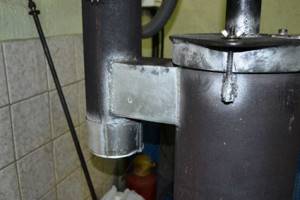
Depending on the type of device, the structure can be created from pipes of different diameters or from iron sheets.
The bottom and metal corners are welded to the walls of the tank, which act as the legs of the structure. To create a lid, a sheet of metal is taken and holes are made in it. The first, with a diameter of 100 mm, is located in the center; the second, 60 mm in size, is located closer to the edge. The lid should be removable, which will make cleaning the stove easier.
A pipe about 37 cm long and 100 mm in diameter is used to supply oxygen. It has holes along the entire length of the element necessary for the supply of oxygen. The pipe is welded perpendicular to the cover at the bottom of the apparatus. An air damper is fixed on it, which will be secured with a rivet or bolts. The hole under the damper should be 6 cm in size. It is intended for supplying oil and igniting fuel.
The design of the upper tank is carried out by analogy with the design of the lower tank according to the drawing of a furnace using waste oil with your own hands. The walls of the product must have a thickness of at least 350 mm. A bottom with a diameter of 10 cm is cut out of the bottom of the tank, which should be placed closer to the edge. A small piece of pipe with a diameter of 11 cm is welded to the bottom of the hole. This is necessary to connect the element to the gas combustion tank.

Before making a furnace for testing, a detailed drawing of the apparatus is made.
Since the top cover of the supercharged exhaust furnace is exposed to high temperatures, a metal sheet with a thickness of at least 6 mm should be used for its manufacture. There is an opening in the lid for the chimney pipe, which should coincide with the opening at the bottom of the container. Between these elements, a partition made of dense metal sheet is mounted, located near the smoke hole. A pipe is attached to the top of the lid, connecting to the chimney part. The self-production process can be seen in detail in the video of the furnace being tested.
Note! To give the structure rigidity and stability, a metal spacer in the form of a piece of pipe with a diameter of 200-300 mm is welded between the chambers.
Manufacturing of a drip furnace
This is a more progressive version of the waste oil heater, and most importantly, safer. In addition, the fuel combustion process is optimized, hence increased efficiency. True, making a drip potbelly stove with your own hands for burning waste is much more difficult; more materials and devices will be required. In particular, you need to adapt a suitable container for a separate oil tank and install a fuel supply pump there.
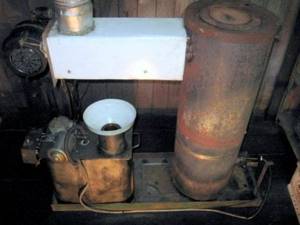
Note. There is an option to install the fuel tank above the level of the furnace so that the oil flows through the tube by gravity.
A homemade drip-type potbelly stove operates as follows. At the bottom of a vertical, round-shaped body (often made from a gas cylinder) there is a bowl where the combustion process takes place. A tube is connected to the bowl, from which waste oil drips.
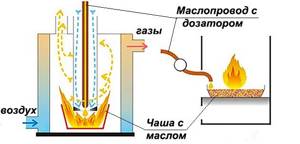
From above, inside the firebox there is a pipe with many holes or slots designed to supply secondary air and pyrolysis afterburning of vapors. Hence the name of this element – afterburner. How to make a similar potbelly stove for a garage is shown in detail in the drawing:

The design of the stove shown in the drawing provides for the supply of fuel by gravity, and the air enters the firebox naturally, due to draft in the chimney. The number and diameter of holes are also calculated for such work. It is important that the fuel supply tube runs inside the afterburner, which allows the waste to be preheated before combustion.
Important. A small hole with a cover is made in the upper part of the heater. It plays the role of an inspection window and an explosion safety valve; in the event of a strong bang inside the stove, this cover will simply fly off to the side, but the body will not burst.
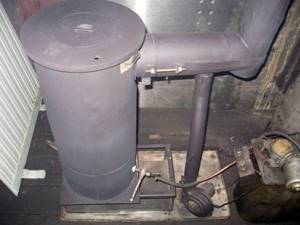
The improved drip potbelly stove for the garage has a forced supply of waste oil and air injection by a fan. In this case, the afterburner pipe does not penetrate the top of the stove, but enters it from the side, through the chimney pipe. But the stainless steel tube that supplies fuel to the combustion zone is laid directly through the body to the bowl. How this is done in practice can be clearly seen in the photo:
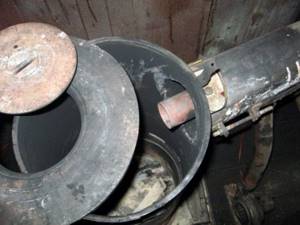
A good idea has been introduced here - use a stove with burners as an explosion valve. The design of the afterburner has also been changed. Instead of many holes along the entire length of the channel, oblique slits are made at the end of the pipe using a grinder. Moreover, advanced craftsmen make the size of these slots adjustable in order to control the flow of secondary air. Primary air enters the bowl through the lower hole in the pipe.
The result is an even and powerful flame that shoots in all directions and heats the body of the unit red-hot. Imagine that the oil consumption in the heater shown in the photo is no more than 1 liter per hour, while a potbelly stove is quite enough to heat a medium-sized garage. Those home craftsmen who want to delve deeper into the topic of efficient combustion of waste oil are recommended to visit the specialized forum termoportal.ru.
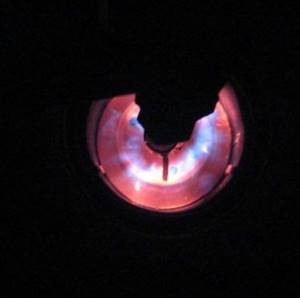
Step-by-step instructions for making a waste oil stove with your own hands from a cylinder
The device can be made from old items using the presented drawings of a waste oil furnace. For this process you will need a gas cylinder with a capacity of 50 liters. You should also prepare:
- pipe with a diameter of 80-100 mm and a length of 4 m;
- steel corner for making a stand and internal elements of the heat exchanger;
- sheet steel for making the bottom of the upper chamber and the plug;
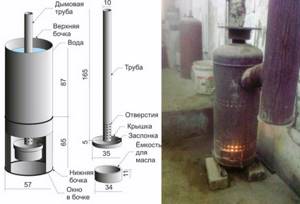
For the manufacturing process of a waste oil furnace, you will need a gas cylinder with a capacity of 50 liters.
- brake disk;
- fuel supply hose;
- clamps;
- half-inch valve;
- loops;
- half-inch oil supply pipe.
An empty gas cylinder is used to make the body. You need to unscrew the valve on it, after which you should leave it outside overnight to ventilate the remaining gas. A hole is drilled in the bottom of the product. To prevent the formation of a spark, the drill must be moistened with oil. Through the hole, the cylinder is filled with water, which is then drained, washing away the remaining gas.
Two openings are cut in the cylinder. The top one will be used for the combustion chamber, where the heat exchanger will be installed. The lower one acts as a burner with a tray. The upper part of the chamber is specially made large. If necessary, it can be filled with other fuel options in the form of firewood or pressed briquettes.
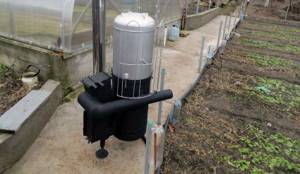
A stove made from a gas cylinder will be more economical and efficient than one made from other materials.
Next, the bottom for the upper compartment of the device is made from sheet metal 4 mm thick. A burner is made from a piece of pipe 200 mm long, as shown in the drawing of a waste oil stove. There are many holes made around the circumference of the product, which are necessary for air to enter the fuel. Next, sand the inside of the burner. This will eliminate the possibility of soot accumulating on the ends and uneven surfaces.
Burner for testing: varieties, device, how to make it yourself (read more)
The furnace burner is exhausted from a gas cylinder and welded to the bottom of the upper chamber. If there are no mining reserves, wood can be laid on the formed shelf.
The process of making a mini potbelly stove yourself
A potbelly stove is a type of stove device that you can easily assemble yourself, and the costs will be minimal, especially if you have a frame for the stove, which can be an empty gas cylinder. Having previously prepared all the necessary tools, you can start working:
- bubble level;
- construction centimeter;
- welding machine;
- angle grinder;
- chisel;
- Metal sheet;
- metal pipe for chimney;
- barrel (for a cylinder-shaped model).
On this topic, we recommend that you familiarize yourself with the material on our website: “Independent production of a potbelly stove for a bath: the main options for a stove device.”
The most current version of the boiler is wood-fired. Due to its high efficiency, such a device can quickly warm up a room. This is the option we will consider. Below are detailed instructions for assembling a wood-burning stove yourself.

[Photo 2 Standard model of a potbelly stove, based on an empty gas cylinder.]
Making a tray for working off and installing a chimney for an oil stove with your own hands
According to the drawing of the stove, a cast iron automobile brake disc, which has good heat-resistant characteristics, is used to make a waste oil pan. A steel circle is welded in its lower part, which forms the bottom. At the top there is a lid through which air enters the oven.

A cast iron automobile brake disc is used to make the pan.
On a note! It is better to make the opening wide. This will provide sufficient air draft so that the oil will flow into the pan.
The next stage in the manufacture of a stove using waste oil from a gas cylinder is to make a coupling from a 10 cm long pipe that connects the burner and the pan. Thanks to this element, servicing the stove will be much easier. You can remove the tray and clean the bottom of the burner. To ensure the supply of oil, a metal tube is inserted into the hole in the housing and secured by welding. An emergency valve is installed on the pipe.
The chimney structure is made of a pipe with a diameter of 100 mm. One end of it is welded to the hole in the central upper part of the body, and the other is brought out to the street.
On a note! The chimney pipe through the wall must pass through a special fireproof glass.
By watching the video “Furnace using a gas cylinder”, you can familiarize yourself with the sequence of actions in the manufacture of the device.
Sequencing
The future version of the furnace design is a chamber with two compartments. In the upper part, combustion of combustible materials will take place, while the lower part acts as an ash pit. Installing a metal grill helps separate the compartments. The design is also equipped with two doors, one is used to close the firebox window, the second is for cleaning the ash pan. The upper part of the mini-oven is additionally equipped with a pipe that serves as a chimney pipe. Below we present several current variations in the assembly of a compact stove-stove.
We recommend that you study the material on the topic in more detail on our website: “Step-by-step instructions for assembling a potbelly stove with a two-zone firebox.”
The cylinder, which is the container of the furnace structure, will have a horizontal loading of fuel. You will need an empty gas cylinder. There is no need to divide it into 2 zones; it is enough to weld the ash chamber in the lower part, which will significantly increase the working volume of the structure. The next step is cutting out a window for the combustion chamber.

[Photo 3 In the lower part of the cylinder body, backlashes are drilled through which spent fuel will enter the ash compartment.]
The door for the combustion chamber is purchased separately and mounted in pre-prepared gaps. After completing the welding of the ash pan, you should begin to support the potbelly stove. Using a welding machine, it is necessary to attach pipes to the bottom of the cylinder, the length of which can be selected according to individual preferences. On the reverse side you need to make a neck for attaching the pipe (flue pipe).
We recommend that you study in more detail the material on the topic: “Independent production of a potbelly stove from disks” on our website.
If free space is limited, it is better to choose a vertical design model. In this case, dividing the cylinder into 2 compartments will be mandatory. Inside, on the side walls, you need to weld fasteners on which the dividing grid will be installed. The top is insulated with a sheet of metal, which can additionally serve as a hob.

[Photo 4 The vertical model of a mini-stove saves free space and allows use as a stove for heating food.]
Advice! It is not recommended to use thin metal for the bottom of the combustion chamber, which will quickly lose the necessary properties during frequent use. A cast iron grate is the best option. For the plug, you can use a cast iron pot, which can be additionally adapted as a container for heating liquid.

[Photo 5 A cauldron with an aluminum lid will serve as an ideal plug.]
To attach the chimney, you will need to weld a pipe at the rear, at an angle of 90°, to which you need to connect the chimney.
How to make a pyrolysis type stove
A potbelly stove during mining consists of three main elements:
- oil containers with lid and valve;
- closed combustion chamber;
- afterburning chambers.
The stove must have a chimney, the length of which is at least 4 m. The oil container, according to the do-it-yourself potbelly stove drawing, is made from a piece of pipe with a diameter of 345 mm and a length of 100 mm. A sheet metal cover is welded to its lower part. The removable top cover is made of a pipe with a diameter of 352 mm, to which sides with a height of 600 mm must be attached by welding. The lid has a central hole of 100 mm in size, intended for the combustion chamber, as well as a side hole (60 mm in diameter) for air injection, which is closed by a rotating lid.
Note! By adjusting the clearance of the blower, you select the combustion intensity of the stove, which affects the air temperature in the room.
According to the drawing of the stove during testing, a pipe with a diameter of 352 mm and a height of 100 mm is used to make the afterburner. Holes measuring 100 mm are made in its lower and upper parts. The first is for the combustion chamber pipe, and the second is for the chimney. Closer to the chimney opening, it is necessary to weld a partition 70 mm high and 330 mm wide.
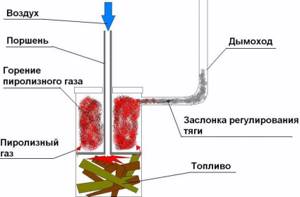
Diagram of a pyrolysis-type furnace.
Using a drill, holes are made in the combustion chamber pipe along its entire height, leaving the lower zone 20 mm high and the upper zone (50 mm) unused. After completing all welding work, the tightness and reliability of the seams should be checked. Next, a furnace test is organized. The waste is poured into the oil container. Kerosene is added on top. Careful ignition is carried out with the ash pan open, with the help of which, after heating the oven, the heat intensity is adjusted.
Note! Testing the furnace during testing should be carried out outdoors, which will avoid a fire indoors or other accident.
To heat a garage, small workshop or living space, you can use a waste stove, which has a number of advantages. The device can be purchased ready-made or made independently using drawings from the Internet. Before making a stove, you should study the sequence of actions in order to subsequently obtain a practical and effective device.
Work on other types of fuel
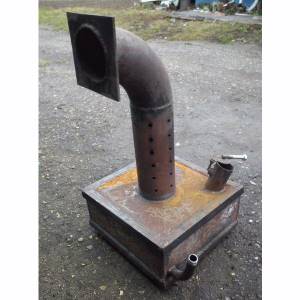
There is no need to bother with exact adherence to the millimeter - many craftsmen assemble potbelly stoves by working on them “by eye”, obtaining excellent results.
In our reviews, we have repeatedly published diagrams of conventional wood-burning stoves, including the pyrolysis type. They are made from sheet iron or old gas cylinders. Being equipped with large fireboxes, they allow you to burn almost any type of solid fuel. If you try, you can make a universal heating device - this is a wood-burning stove.
To do this, you will need an exhaust burner, shown in the figure below. Here we see the same primary combustion chamber with a perforated vertical tube connected to it. Only the final combustion will take place not in the secondary chamber, but in the chamber of the wood-burning stove. Your task is to arrange a removable door on it so that you can turn on the presented burner instead.
Converting a potbelly stove for mining is not particularly difficult - just use the diagrams and tips published in our review.
